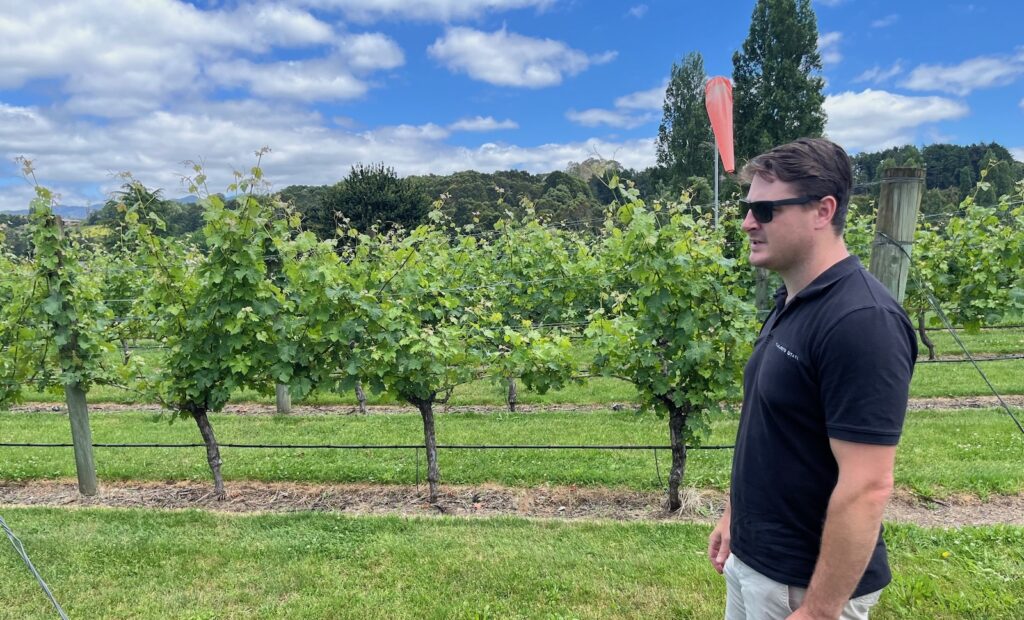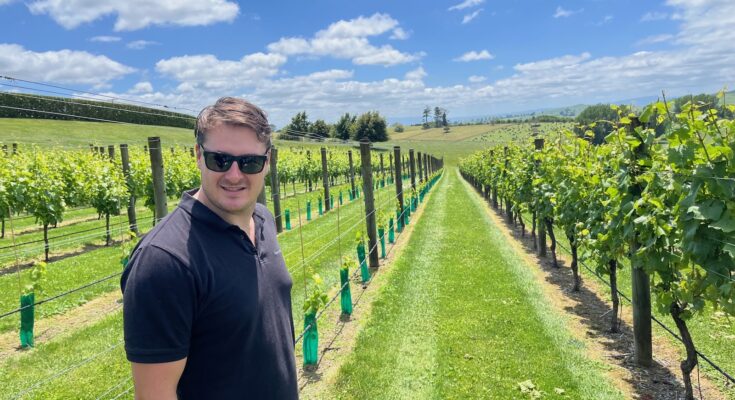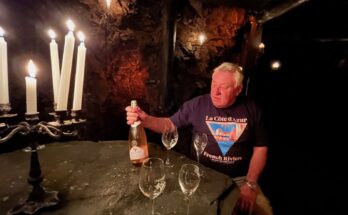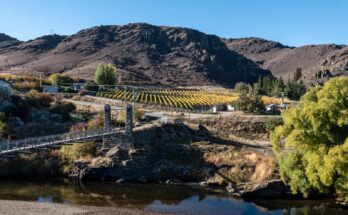A visit today, on a beautiful sunny early summer afternoon, to the shore of Karapiro in the Waikato – and to Takapoto Estate. The estate is set up to be the best of the best – it is primarily an elite equestrian centre, but also has a rather nifty sideline in wine. I’m hosted by winemaker Alex Coldicutt, and Matt – who used to be one of the winemakers at Allan Scott in Blenheim, and now looks after the viticulture side of operations here. Takapoto Estate is owned by Mitch and Kate Plaw, who own Architectural Profiles Limited.
It is a 600-acre property that sits on three kilometres of waterfront on Lake Karapiro, near Cambridge in the Waikato. The park accommodates vineyards, livestock, a horse breeding program, equestrian training and competition facilities, plus a market garden, resident bees – a year-round pantry for the birds of Maungatautari mountain.
Takapoto’s wines became famous when Andy Anderson, the previous winemaker who sadly passed away in 2019, won 2 Trophies for the Best Pinot Noir at the International Wine and Spirit Competition (IWSC – one of the world’s most prestigious competitions. He won the first with his Bannockburn 2012 Pinot Noir, and then, with the Gibbston Valley 2014 Pinot Noir – the fruit sourced respectively from Legend’s Terrace in Bannockburn, and Cox’s Vineyard in Gibbston Valley.
Takapoto Estate produces excellent wines from grapes that are grown in their most suitable climates throughout New Zealand. Chardonnay in Hawke’s Bay, Pinot Noir in Central Otago and a Bordeaux Blend (single varietal Cabernet Franc, and Blend of Cabernet Sauvignon, Merlot and Malbec) from their own region of Waikato and Bay of Plenty.
I ask if they are looking to go into organic farming, and Alex tells me “We tried to go organic here – early on – but the site was just not the right site for organics. There are definitely sites that work and should be organic, but the climate we have here is not one of them”.
The on-site nursery uses seeds harvested from the nearby Maungatautari mountain and has helped to produce the 750,000 native plants that have been put into the land. The upper vineyard sits on what is about the best spot on the whole property. Soils are a clay-loam. The oldest vines are Cabernet Franc, planted in 2008. Chardonnay is Mendoza and Clone 95, and there’s also some Pinotage. This is supplemented by fruit from Hawke’s Bay and Central Otago. Alex is also keen on trying something else – “I might be getting a 1000 litres of Sauvignon Blanc from Marlborough – something small. We do get asked for a Sav a lot, so we probably should have one. I just don’t want to grow it!”
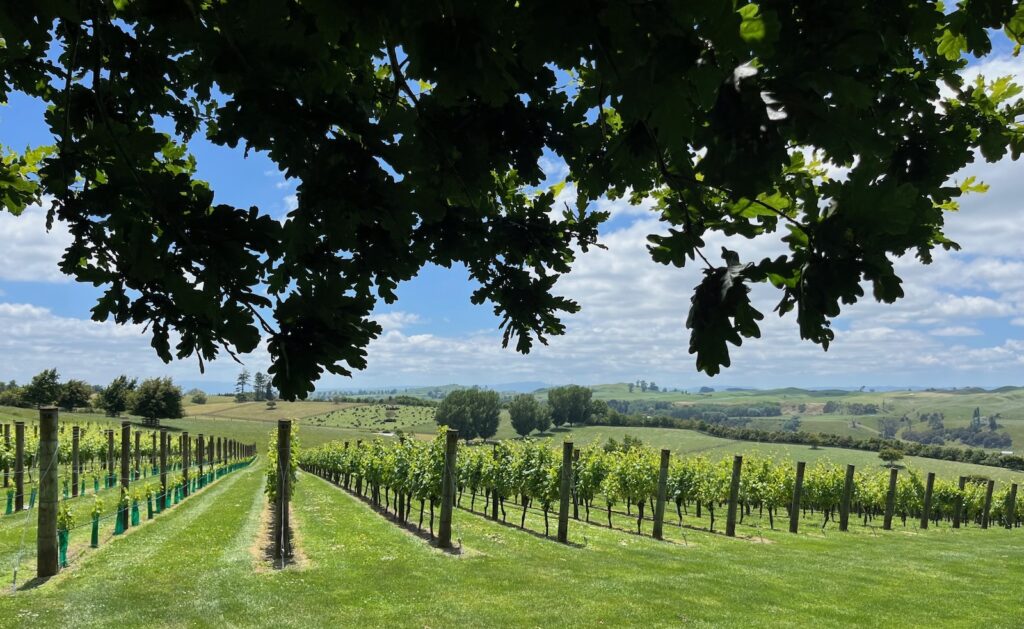
I ask what the goal is for Takapoto Estate?
Alex Coldicutt: This vineyard was started as a hobby for the owners. A couple of barrels of wine. But I’m really keen to get The Crossing Point wines taken more seriously. This is what I’m more focussed on. It’s not about making money. It’s about good quality wine, made here.
Winefolio: And you used to get Endeavour fruit from Tim at Clearview?
AC: Fruit from Clearview, yes – It was 2017 that we stopped getting that Endeavour fruit specifically. I recall clearly in 2020 I had one trailer load and I ran out of gas 30kms shy of the Taupo gas station. And a 3-litre jerry can was all they would give me. Without a spout! I thought I was going to run out of gas twice. I went through very little gas on the way there – because it was empty.
Mitch Plaw has bought 49% of Trinity Hill, so we’ve got access to fruit from the 125 Gimblett vineyard. Swapped one banging vineyard for another, so it’s not all bad is it? Our Chardonnay here was planted in 2010. The Pinotage first crop which was 2020 – was unbelieveably good. I almost kept it separate, but I needed it for the red blend.
WF: Is Pinotage one of those ones where it grows like a weed and you have to keep on top it?
AC: Yes. Although most of our reds are down in that other vineyard if you can see it – down on the Point? Merlot, Malbec… the lake acts as a moderator for temperatures. And we went hard on early thinning this year. The site is really vigorous, but you can see how open these vines are. I use hungarian oak for the Pinotage, that seems to work well. That was a gift from Andy, the winemaker who was here before – my mentor. When he passed away, I found one unused hungarian oak barrel and I thought ‘what am I going to do with this?’ I put the Pinotage in it and loved it.
WF: Did the Cyclone affect you badly?
AC: Yes, massively. The Chardonnay here is 0.6 hectare. Last year we got ten barrels off it. 2023 we got two. Down 80% and we didn’t harvest any reds. Just did rosé. Even the Chardonnay – we had to do a different style. We got frost this year – the 7th of October. That never happens. We’ve got blueberries planted around the winery, and they lost 90% of those this year. It wasn’t the worst thing though – our Merlot crops so heavily and we drop so much fruit on the ground – but it made it push up some secondary shoots which are lower cropping. Meant we dropped a lot less. Natural fruit thinning.
I’d love to say that every day we have weather like this. It’s not! We’ve got irrigation lines here and they have not been turned on since the vines were babies. We had to work out recently if these are even still connected! We get enough rain in a season.

WF: Can we have a quick look at the Cabernet Franc?
AC: Yes. This was planted in 2008. We use half of it for the rosé and the other half goes into the red. For the rosé we pick it earlier and foot stomp it here in the vineyard, drive it to the winery and press it. It gives almost no colour, even after all that time.
WF: That rosé was very popular at Vic Road in Devonport, where I managed. It’s not just the pale colour, which obviously helps.
AC: I can’t believe it at the moment. Even the 2024 is flying out. You can do off-dry as long as it has good acid, which this does. I don’t even test the numbers when I do that, it is just off the palate.
WF: Any thoughts to do anything else? Like a gin or a vermouth off the property?
AC: Well, you can try a gin we’ve made from here. It’s called Forager’s Gin by Takapoto. Have you heard of ‘Elsewhere Gin’ before? It’s a guy called Mark and he is the brother of Andy who was the original winemaker at Takapoto. Mark was at Pegasus Bay. He goes to a site and forages all the botanicals, and he’s come here and done that. Mostly natives, but then from the Market Garden as well. We distilled some rosé and aged it in an oak barrel, to bring back the wine side. It’s a really small batch gin and we haven’t done too much with it yet.
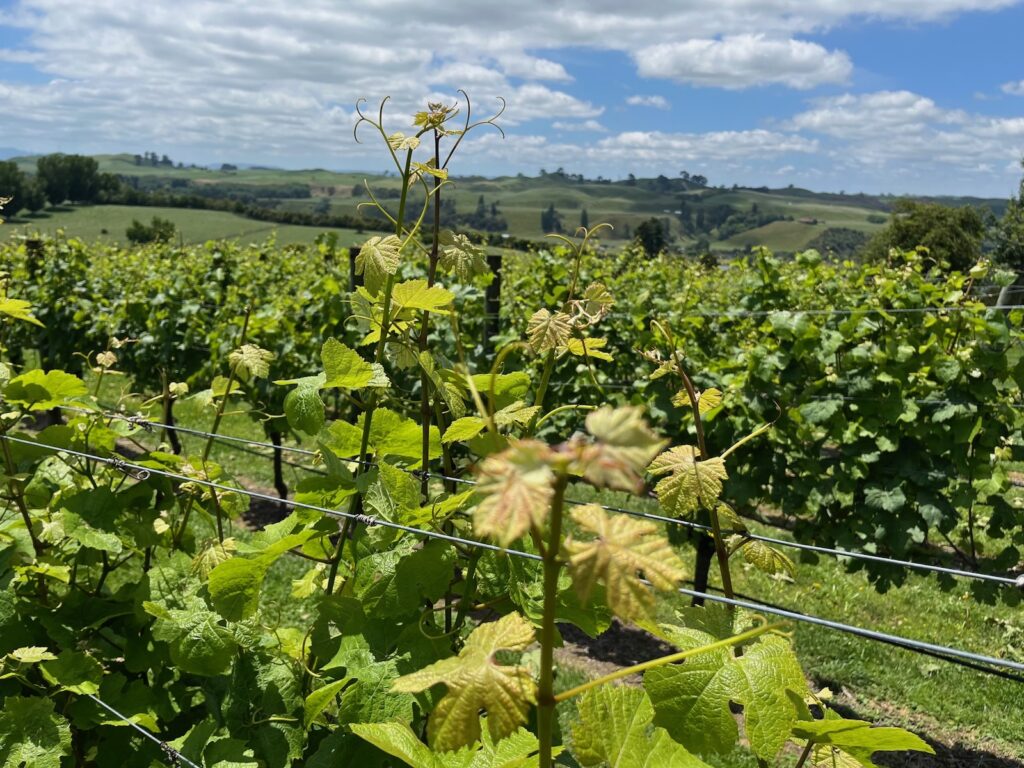
We take a drive down to the lakeside, on the property’s northern border. Considering that Takapoto is well-known for horse events, there is a brief discussion about how good the land would be for a cross-country equestrian event, like Badminton (which was not far from where I’d lived for a while in the UK). The land is so well looked after, with many native plants and even Kauri trees that have been grown from seed in the nursery. I notice a couple of boardwalks heading into the bush, and Alex confirms that there are hundreds of metres of bush walks through the trees. It used to be a deer farm and they still have some deer on the property.
We arrive down at the vineyard by the lakeside, where there is much more free-draining soil, with a thin layer of topsoil and then sandy loam and pumice. The Cabernet Sauvignon was planted around 2012. A small table has been set up with a chilly bin underneath containing multiple wines – some of which even Alex has not looked at for a very long time! Just where we are, I can look across to ‘The Crossing Point’ across the water, which, back in the day, was a trading spot.
Taking a deep breath we get started with the first vintage that was commercially-grown on-site of the Chardonnay, which was 2017. It was made by Andy – and it’s a great colour! It is very clean though, despite the golden tone – with a lovely grapefruit citrus top note. Maybe just a touch of green, but not too bitter, and quite viscous and a little slippery. Then the 2018, in a dry year, showing more oak, with a rich, nutty flavour and plenty of power on the palate. I like this one a lot, with a riper, more stonefruit-orientated character. Great concentration.

There was no Chardonnay made from Crossing Point fruit in 2019 or 2020, and the 2021 was Alex’s first attempt. Picked a bit earlier, and there’s more freshness and a bite of acidity here. Still quite generous, with nectarine on the nose, but now I’m getting floral notes like elderflower and lemon blossom. Alex had taken over and Chardonnay hadn’t been made for a while, so he had no used barrels. So there’s quite a lot of new oak in it!
The 2022 Crossing Point is zesty and leaner – a contrast to the earlier wines. There is a definite ozone character – something like the petrichor, smell of rain. In 2023 only two barrels were made. The grapes picked early out of necessity and has no new oak in it – Alex didn’t think the juice could handle it. It is different wine – the acidity is maybe a bit tart for now, but give it time and it might mellow into itself. The vintage variation is big, but to also see a change in winemaking style, from the first two ‘big’ wines into more balance.
We jump back – to a 2015 Takapoto Reserve Chardonnay. Alex thinks this was from Clearview Estate’s ‘Endeavour’ fruit, and was barrel fermented down in Te Awanga. It looks and smells like that famous Chardonnay – the oak is heroic. So spicy and creamy. 100% new oak of course. The palate swallows it up though, so what seems so forward on the nose, is just a seasoning as you taste. I ask if that’s a style that is still popular?

AC: I was talking to Hamilton Wine and Beer, which is the biggest wine shop around here. And they said that they see a lot of winemakers, and critics, going against that trend. But that is what the consumer wants. I remember when I was a 24-year old and just taken over winemaking, and I was a bit lost. I rock up to Clearview with my barrels, and Matt says “oh you’ve only got 40% new oak there – Andy will be rolling in his grave!” And I was horrified! As I hadn’t made the wine myself I didn’t want to put 100% new oak in. But I am happy with the style I’m doing now – to be honest I look at it as I go along. I have pulled back on the oak. We’re looking for classy and elegant.
We also look at Alex’s first vintage for the Takapoto label that uses Hawke’s Bay fruit. The 2021 used two 300-litre barrels of new oak. And then back through all of the run of wines back to 2018 of the Takapoto Reserve are quite bold wines, with generous vintages for the grapes – all of which come via Clearview Estate one way or another. The 2017 and 2016 bottles are the only ones that are ‘a miss’ for me. Both have good fruit ripeness, but need more energy, drive and less reliance on oak and/or concentration for effect. Way too much butterscotch on the nose in particular. But – the 2015 is much more balanced and has a vibrant freshness, albeit with a lot of oak still showing.
We quickly dash onto some reds – starting with the 2016 Crossing Point Red. Alex pours saying “I don’t have a clue how this has aged, so we’ll find out”. The blend is Cabernet Sauvignon, Merlot and Malbec. It is a bit herbaceous, a bit savoury – almost with a burnt character – so, the answer is.not that well!… Then the 2020 red which is a blend of Merlot, Malbec, Cab Sav, Pinotage and Cab Franc, in that order. This is a lot better – ripe plum and warm leather. I like it – it is a ‘quaffing red’ but with enough complexity going on to hold your interest.
Alex adds that before the Pinotage went in it was quite jubey and juicy, so it gave structure where needed. This year, in 2024 they put all the Merlot into rosé, which made that fantastic, but leaves the red as quite a different wine. The Crossing Point Red is a wine that they all want to work up to be a much better wine. From looking at the vineyards, I’d say the potential is there.
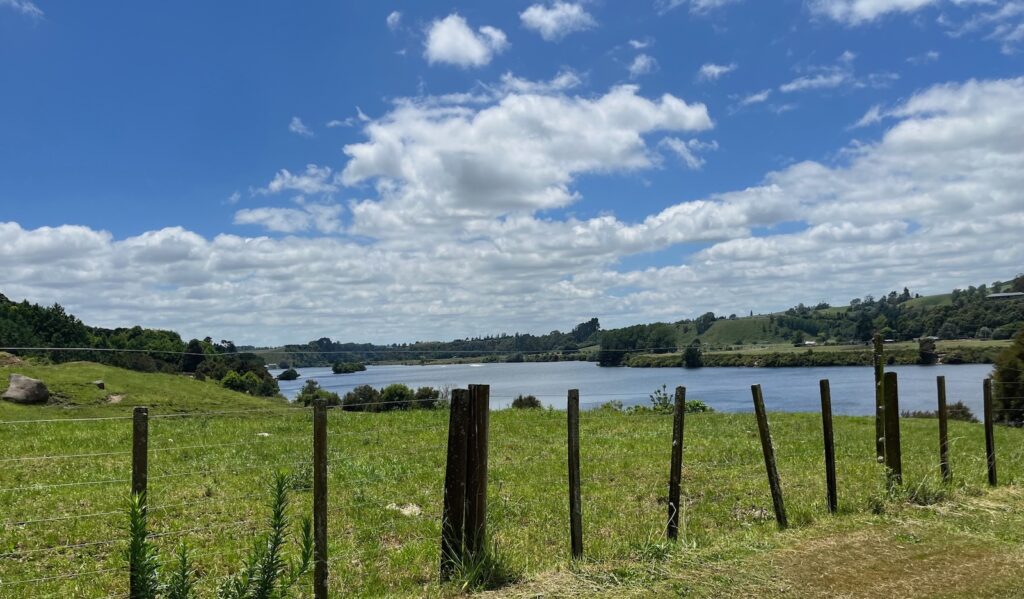
Their Pinot Noir, under the Takapoto Estate label comes from Central Otago. First up is the blend from 2020 – the vineyards are Legend’s Terrace in Bannockburn, and Brennan in Gibbston. They make single vineyard wines from each and what doesn’t make it into those becomes the blended wine. The vineyards do complement each other, in this wine. Obviously a single vineyard expression is good at showing what they are about. But this has long, supple tannins, ripe fruit, red spices and is a lovely balanced Central Otago Pinot. I ask if it is crushed when they receive it?
AC: No, I have it sent up as grapes. It takes around thirty hours. But the tension around getting here – with the ferries – I am a nervous wreck. Once it is on the North Island I’m OK. I usually have two picks. Very uneconomical but I don’t want to compromise the quality of the fruit for the sake of that. This one is 68% Bannockburn.
The Pinot has some characters from both – with a raspy tannin going across the tongue, but also a lighter, floral note. Filled with strawberry, cherry and cranberry flavours, it slips down elegantly. A 2016 shows much more clearly Christmas spices, with clove and nutmeg. It feels really ready to go. I wouldn’t want to cellar this much longer. Alex tells me that the ’16 is actually the current release! The last wine out is that very, very good rosé. It is very pale – a barely-pink expression in terms of the colour. There are some green, grassy garrigue notes, with white peach and a little smokiness there too. Definitely heading off-dry, but that fruit sweetness adds some texture too, and there is excellent acid linearity.
The last thing we do on this visit is to head back to the main building – where there is a quite magnificent seating area for guests. We sit in the cool – it has a been a pretty hot early afternoon (not that we’re complaining) and just have a chat. Alex had put a couple of wines into the Top 10 Tasting of Chardonnay that I published at the end of November, and he’s keen to hear about the ins and outs of doing that. I talk about the differences between doing judging and reviews – and again, how that goes. He’s surprised to hear how quickly I can write a review, but not surprised when i say just how much work it is to put together the Top 10 Tastings! It has been a lovely visit – I do heartily recommend that you make the effort to give them a call and organise an appointment here. They’re not open to casual callers, but Alex is keen to host anyone who shows an interest.
Takapoto Estate – http://www.takapoto.co.nz. The ‘Takapoto Classic’ showjumping event is on at the end of February 2025. At other times you can make a Tour Booking via the website – or buy wines and gin.
